
The Teatro de la Cruz was, during its nearly 200-year existence, the principal theater for comedy in Madrid.

The Teatro de la Cruz was, during its nearly 200-year existence, the principal theater for comedy in Madrid.
Founded by the Hermandad de la Soledad in 1584, it soon became the premier venue of its time for Spanish comedy.
In 1743, it was extensively renovated under the direction of the architect Pedro de Ribera, who transformed it into a modern theater seating 1500 spectators.
During the nineteenth century, Ribera's architectural style, and specifically the style embodied by the Teatro de la Cruz, came under intense official criticism; a Royal Order in 1849 officially declared the theater a "shame of art," and ordered it to be demolished forthwith. However, the demolition was not immediate; the theater reopened in 1850, only to be closed again between 1852 and 1857. Finally demolished in 1859, its existence is commemorated by a small plaque located at its former location, the intersection of Calle Espoz y Mina and Calle de la Cruz in central Madrid.
Several major works premiered on its stage, including El barón (1803), La mojigata (1804), and El sí de las niñas (1806) by Leandro Fernandez de Moratin, and Don Juan Tenorio (1844) by José Zorrilla.
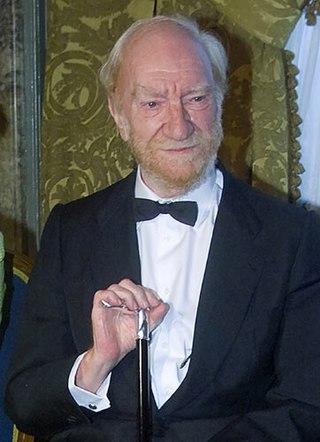
Fernando Fernández Gómez, better known as Fernando Fernán Gómez, was a Spanish actor, screenwriter, film director, theater director, novelist, and playwright. Prolific and outstanding in all these fields, he was elected member of the Royal Spanish Academy in 1998. He was born in Lima, Peru while his mother, Spanish actress Carola Fernán-Gómez, was making a tour in Latin America. He would later use her surname for his stage name when he moved to Spain in 1924.

The Teatro Real is an opera house in Madrid, Spain. Located at the Plaza de Oriente, opposite the Royal Palace, and known colloquially as El Real, it is considered the top institution of the performing and musical arts in the country and one of the most prestigious opera houses in Europe.
José de Cañizares y Suárez was a Spanish playwright. Cavalry officer, public official, and author of around one hundred works, he was one of the most important dramatists of the early 18th century.

José Jurado de la Parra was a Spanish journalist, poet and playwright. He was the son of Juan Antonio Jurado Gámez and María de las Dolores de la Parra Segura. He had two brothers, Andrés, a military doctor and writer, and Anacleta. He was a disciple of Campoamor and Pérez Galdós and a close friend of José Zorrilla and Blasco Ibáñez, as well as Antonio Fernández Grilo, a poet from Córdoba. He arrived in Madrid in 1870, the same day, December 28, that General Prim was assassinated on Calle del Turco.

Tomás Luceño y Becerra was a Spanish poet and playwright.
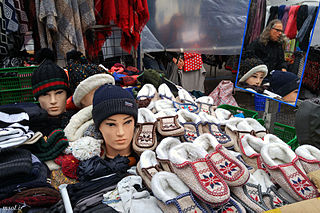
El Rastro de Madrid or simply el Rastro is the most popular open air flea market in Madrid (Spain). It is held every Sunday and public holiday during the year and is located along Plaza de Cascorro and Ribera de Curtidores, between Calle Embajadores and the Ronda de Toledo.
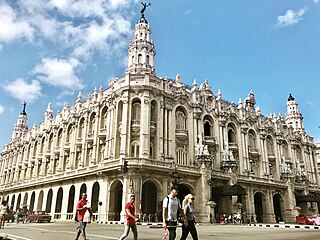
Gran Teatro de La Habana is a theater in Havana, Cuba, home to the Cuban National Ballet. It was designed by the Belgian architect Paul Belau and built by Purdy and Henderson, Engineers in 1914 at the site of the former Teatro Tacón. Its construction was paid for by the Galician immigrants of Havana to serve as a community-social center. Located in the Paseo del Prado, its facilities include theatres, a concert hall, conference rooms, a video screening room, as well as an art gallery, a choral center and several rehearsal halls for dance companies. It hosts the International Ballet Festival of Havana every two years since 1960.

The Municipal Theatre of Lima, inaugurated as the Teatro Forero, is a theatre and concert hall in the historic centre of Lima, Peru. It is home to the country's National Symphony Orchestra.
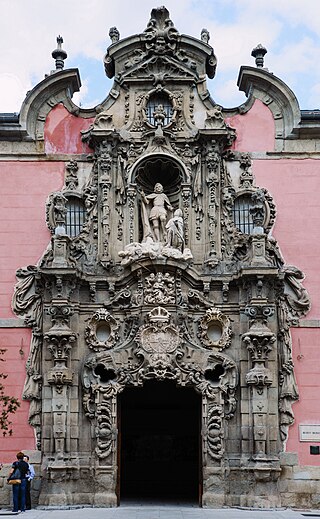
Pedro de Ribera was a Spanish architect of the Baroque period.
Antonio Rodríguez de Hita was a Spanish composer.
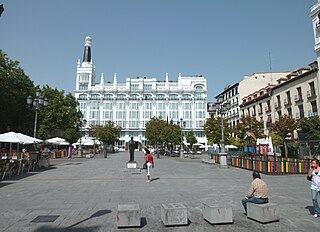
Plaza de Santa Ana is a plaza located in central Madrid, Spain, nearby Puerta del Sol and Calle de Huertas, in the Barrio de las Letras. It features monuments to Spanish Golden Age writer Pedro Calderón de la Barca and to the poet and playwright Federico García Lorca and numerous restaurants, cafes and tapas bars, with its terraces covering most of the sides surfaces.

Teatro Fox Delicias is a historic building in the city of Ponce, Puerto Rico. Inaugurated in 1931, it originally housed a movie house until 1980, from 1991 to 1998 it house a shopping mall, and stating in 2004 it housed a boutique hotel. Its architecture is Art Deco. Originally called Teatro Delicias, it was renamed Fox Delicias many years after its inauguration based on a contract with 20th Century Fox.

Teatro Español, formerly Teatro del Príncipe and Corral del Príncipe, is a public theatre administered by the Government of Madrid, Spain. The original location was an open-air theatre in medieval times, where short performances and some theatrical pieces, which became part of famous classical literature in later years, were staged. Its establishment was authorized by a royal decree of Philip II in 1565.
Olinda Bozán was an Argentine film actress and comedian of the Golden Age of Argentine Cinema (1940–1960). Born into a circus family, she acted on the vaudeville circuit, and performed in silent and sound movies. She was trained by the Podestá brothers, one of whom she married, who have one of the most prestigious Argentine acting awards named for them. Bozán' appeared in 75 films and was considered one of the best comic actors of Argentine cinema in the 20th century.

Teatro Apolo is a defunct theatre in Madrid, Spain. It was located on Calle de Alcalá, at the site which is now number 45. Previously, the site was occupied by the Convento de San Hermenegildo, which was sold off in 1836 and demolished in 1870. Theatre construction occurred between 1871 and 1873, with a design by the French architects P. Chauderlot and F. Festau. It had a capacity of 2,500 people. The theatre opened on 23 March 1873 and featured the company of actor Manuel Catalina. A comedy playhouse, it went through difficult times in its early days due to its relative distance from the then city center and the high ticket price. The Apolo and the Felipe theatres were the most important venues for the género chico, a phenomenon which debuted in Madrid and featured one-act performances. The Apolo closed its doors on 30 June 1929 after it was purchased by Banco Bilbao Vizcaya Argentaria, which demolished the theatre in order to construct its Madrid headquarters. The site now contains a building which houses the Department of Finance and Administration of the City of Madrid. The Apolo's owners went on to build the Teatro Nuevo Apolo.

Lluís Graner i Arrufí, or Arrufat in Spanish was a Spanish painter in the Realistic style, artistic director and theater entrepreneur. After achieving notable success in painting, he moved into lighting design for theatrical shows and developed the Catalan lyrical theater genre of "musical visions".
The Walls del Arrabal were the third in a set of five walls built around Madrid, now the capital of Spain. There are no remaining ruins of the Walls del Arrabal, leaving some debate as to their extent and the period of their construction. It is possible that the walls were built as early as the 12th century, however they were most likely constructed in 1438. The walls may have been intended to protect people against the plagues that ravaged the city at the time. The walls united the urbanized suburbs of the city and prevented entry of the infected.

Malasaña is an area in the centre of Madrid, Spain. While it doesn't align with any specific administrative division, it is frequently associated with the Universidad neighborhood, the broader administrative district in which Malasaña is situated. The tourist information webpage from the Madrid City Council defines its boundaries as the streets of San Bernardo, the Gran Vía, Fuencarral and Carranza. Malasaña is associated with a creative and counter-cultural scene.

Francisco Lleroa y Salas was a Spanish classical opera singer (bass-baritone), one of the crucial figures in the revival of the zarzuela genre.

The Plaza de Isabel II is a historic public square between the Sol and Palacio wards in the central district of Madrid. The plaza is at the convergence of Arenal Street and the minor roads Arrieta, Calle de Campomanes, Caños del Peral, Escalinata and Vergara. It was formed by filling the ravine created by the Arenal stream and the source of the Fountain of the Canals of the Pear Tree. The square occupies part of the site where the old Theater of the Caños del Peral stood between 1738 and 1817.